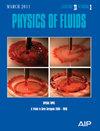Numerical investigation on Al2O3 droplet spreading and its prediction model exploration based on Harris Hawks optimization-generalized regression neural network in stereolithography
IF 4.1
2区 工程技术
Q1 MECHANICS
引用次数: 0
Abstract
The laying process is crucial in using stereolithography (SL) for molding Al2O3 parts. However, most studies focus on the laying process of macroscopic slurry; there needs to be more focus on microscopic exploration. Studying from a microscopic perspective can help us understand the influence of its parameters on droplet spreading and infer the macroscopic changes of the slurry based on the changes in droplet spreading to understand why parameters cause macroscopic changes in the slurry. A pseudopotential model based on Sisko's non-Newtonian behavior in lattice Boltzmann method is proposed to study the spreading process of droplets and validated using wetting characteristics. The previous layers of the platform and the printed solid are investigated to understand the effect of laying velocity on the spreading diameter, the thickness, and the both-sided contact angles. The results indicate that a higher laying velocity leads to a larger spreading diameter, a smaller spreading thickness, and a smaller left contact angle. However, it also increases the contact angle difference between the two sides, leading to uneven slurry. The droplet spreads more unevenly when the previous laying surface is the printed solid. At the same velocity, the droplet spreads with a smaller diameter, thicker thickness, and larger contact angle on the printed solid surface. Therefore, a higher laying velocity in the SL laying process is not recommended, especially when the front layer is a printed solid. Although a higher laying velocity will increase the laying area and reduce laying time, it will cause protrusions at the front edge, and inconsistent laying thickness of the same layer will affect the following photosensitive curing process. The Harris Hawks optimization-generalized regression neural network algorithm is proposed and compared with other common artificial intelligence algorithms to predict the spreading parameters. The comparison shows that the proposed algorithm provides a more stable and accurate prediction of spreading parameters.基于哈里斯-霍克斯优化-广义回归神经网络的立体光刻技术中 Al2O3 液滴扩散的数值研究及其预测模型探索
在使用立体光刻技术(SL)成型 Al2O3 部件时,铺层过程至关重要。然而,大多数研究都集中于宏观浆料的铺设过程,需要更多关注微观探索。从微观角度进行研究可以帮助我们了解其参数对液滴扩散的影响,并根据液滴扩散的变化推断浆料的宏观变化,从而了解参数引起浆料宏观变化的原因。提出了基于晶格玻尔兹曼法中西斯科非牛顿行为的伪势模型来研究液滴的扩散过程,并利用润湿特性进行了验证。研究了平台和印刷固体的前几层,以了解铺设速度对铺展直径、厚度和双面接触角的影响。结果表明,铺放速度越快,铺放直径越大,铺放厚度越小,左接触角越小。但同时也会增加两侧接触角差,导致浆液不均匀。当前一铺设面为印刷固体时,液滴的铺展更不均匀。在相同速度下,液滴在印刷固体表面的扩散直径较小、厚度较厚、接触角较大。因此,不建议在 SL 铺层过程中采用较高的铺层速度,特别是当前层是印刷固体时。虽然较高的铺层速度会增加铺层面积,缩短铺层时间,但会造成前缘突起,而且同一层的铺层厚度不一致会影响接下来的光敏固化过程。本文提出了哈里斯-霍克斯优化-广义回归神经网络算法,并与其他常用人工智能算法进行了比较,以预测铺设参数。比较结果表明,所提出的算法能更稳定、更准确地预测铺展参数。
本文章由计算机程序翻译,如有差异,请以英文原文为准。
求助全文
约1分钟内获得全文
求助全文
来源期刊

Physics of Fluids
物理-力学
CiteScore
6.50
自引率
41.30%
发文量
2063
审稿时长
2.6 months
期刊介绍:
Physics of Fluids (PoF) is a preeminent journal devoted to publishing original theoretical, computational, and experimental contributions to the understanding of the dynamics of gases, liquids, and complex or multiphase fluids. Topics published in PoF are diverse and reflect the most important subjects in fluid dynamics, including, but not limited to:
-Acoustics
-Aerospace and aeronautical flow
-Astrophysical flow
-Biofluid mechanics
-Cavitation and cavitating flows
-Combustion flows
-Complex fluids
-Compressible flow
-Computational fluid dynamics
-Contact lines
-Continuum mechanics
-Convection
-Cryogenic flow
-Droplets
-Electrical and magnetic effects in fluid flow
-Foam, bubble, and film mechanics
-Flow control
-Flow instability and transition
-Flow orientation and anisotropy
-Flows with other transport phenomena
-Flows with complex boundary conditions
-Flow visualization
-Fluid mechanics
-Fluid physical properties
-Fluid–structure interactions
-Free surface flows
-Geophysical flow
-Interfacial flow
-Knudsen flow
-Laminar flow
-Liquid crystals
-Mathematics of fluids
-Micro- and nanofluid mechanics
-Mixing
-Molecular theory
-Nanofluidics
-Particulate, multiphase, and granular flow
-Processing flows
-Relativistic fluid mechanics
-Rotating flows
-Shock wave phenomena
-Soft matter
-Stratified flows
-Supercritical fluids
-Superfluidity
-Thermodynamics of flow systems
-Transonic flow
-Turbulent flow
-Viscous and non-Newtonian flow
-Viscoelasticity
-Vortex dynamics
-Waves
 求助内容:
求助内容: 应助结果提醒方式:
应助结果提醒方式:


